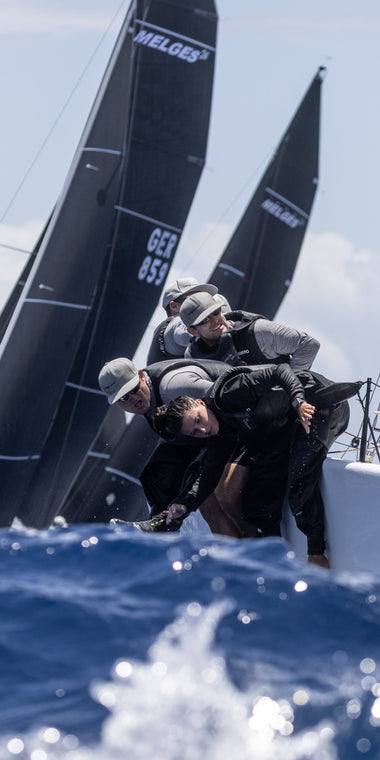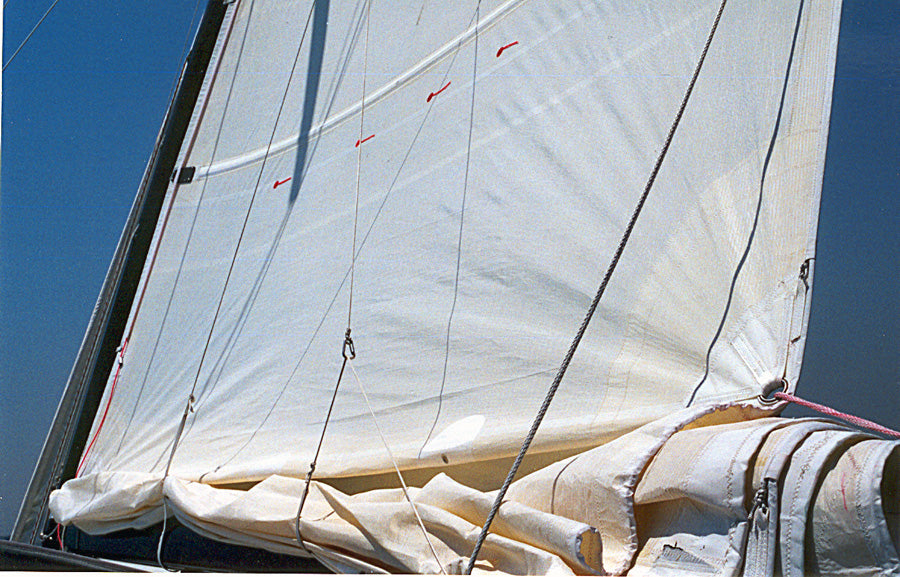THE FOUR F'S OF SAIL FATIGUE: FLEX, FIBER COMPRESSION, FLOGGING, AND FLUTTER
THE FOUR F’S OF SAIL FATIGUE: FLEX, FIBER COMPRESSION, FLOGGING, AND FLUTTER
Our DIY Sail Care information only applies to traditional fabrics and laminates. 3Di is composite technology, not a sail laminate. For info on 3Di sail care, read Sail Maintenance. Here is what you need to know about the Four F’s of Fatigue for traditional fabrics.
No matter what it’s made of, sail laminates and traditional fabrics will eventually wear out. Fortunately, proper care and use can drastically increase the longevity of your inventory. North Sails CEO Dan Neri takes us through the various factors that typically lead to structural failures and shows us how to minimize damage.
Flex Fatigue
Just as UV exposure is an unavoidable bummer if you choose to sail in nice weather, flex fatiguing of your sails is a fact of life if you choose to sail in wind or waves. Any action of the sail membrane that causes it to cycle back and forth will eventually fatigue the materials. On very windy days this includes flogging during hoisting and lowering, rolling furling sails, and flogging while tacking or reefing. The edges of the sails flutter rapidly if leechlines are not tensioned correctly in moderate and strong winds. And in light winds on broad sailing angles, sailboats can roll violently enough to cause the sails to “slat,” which flexes the fabric and shock-loads the attachment hardware.
To avoid flex fatigue:
- Eliminate or reduce flogging.
- Make sure leech and foot lines are adjusted to eliminate edge flutter.
- Change course in light-sloppy conditions to reduce slatting.

Fiber Compression
When sailcloth is bent, one side of the fabric is being stretched and the other side, the inside of the bend, is being compressed. The compressed fibers are the ones damaged. Fiber types that show the most remarkable strength under strain, like Carbon or Kevlar, break down easily when they are compressed. Some fibers crumble and fall apart, turning into powder. Other fibers shatter and displace longitudinally in the same way that a live tree branch fractures when bent in half. Once a fiber shatters, there is more exposed surface area for UV penetration—and the more the fiber is degraded by the sun, the more easily it will crumble the next time it is flexed.
Causes
The most likely causes of fiber compression fatigue are folding the sail for storage and smashing the mainsail fabric under slab reefing lines. When you fold your sails loosely with the folds parallel to the foot, there is no damage to the sail. So a mainsail that is flaked over a boom in exactly the same way every time is fine, and a racing jib that is flaked into a full-length zipper bag is a happy sail. However, when you fold a sail parallel to the foot and then fold it again along the foot in order to get it into a conventional sail bag, the loose flakes are forced into compact 180 degree folds and the fibers on the inside of those folds will be crushed.
Polyester and spectra fibers that are used in cruising sails will stand up to dozens of cycles, shattering just a little each time. When you bag your sails, it is better to fold in a different spot each time (and have hundreds of imperceptibly minor areas of fiber compression) than to fold in the same spot over and over and eventually end up with a hard horizontal line of shattered fibers.
To avoid fiber compression problems:
- Fold sails in loose flakes whenever possible.
- Avoid creasing a sail in exactly the same place each time it is bagged.
- When reefing, push sail fabric to the opposite side of the boom from the vertical leg of the clew reef line.
Flogging
When a sail is allowed to flog, the leech of the sail will sustain more damage than the middle or luff. Think of a lion tamer snapping a big whip. Nothing is happening at the whip handle, but the farther away from the handle, the farther the whip travels and the more violently the whip snaps when it changes direction of travel.
Sailmakers taper the transitions from the base layer of the sail into the heavier areas of the leech. The tapered reinforcements help to soften the effects of flogging and to distribute the fiber flex over a greater surface area. You can reduce flex fatigue by paying attention to the length of time the sail is allowed to flog and the force with which it flogs.
Mainsails
Mainsails are supported on two of three edges, and full-length battens soften the flogging action of the unsupported leech. In breeze under 25 knots, a well engineered cruising mainsail with full-length battens won’t flog at all. Rather, it will wave back and forth while it is being raised and lowered. A mainsail with short battens (usually referred to as “leech battens”) is more adjustable and lighter, but will quickly deteriorate if it is allowed to flog.
Headsails
Headsails are only supported on one of three edges, so an untended headsail can potentially flog itself apart. Accordingly, the sail handling members of a cruising crew need to be ready execute any maneuvers involving the headsail as efficiently as possible. At a minimum that means always having the headsail sheets flaked and clear before a tack, jibe, or furl. Beyond that basic procedure, it is worthwhile to emulate a racing crew even during casual daysailing to minimize the headsail flogging. (For more info, read Club Racing: How to Improve Your Tacks)
Reduce flogging by:
- Keep sails trimmed whenever possible.
- Position headsail leads far enough forward to keep pressure on the upper leech.
- Use an outboard lead for the headsail sheet when reaching.
- Prepare for tacks before casting off old headsail sheet.
- Raise the main in the lee of the land on windy days.
- Run downwind when roller furling on windy days.
- Select a full batten option when purchasing a new main.
- Keep at least moderate tension on sheets when the boat must be stalled temporarily.
Furling
When it is time to roll up the headsail, both sheets need to be ready to run free and the person who will be hauling in the furling line must be in place and braced for the activity. If the furling is done with a winch, some drag should remain on the sheet to reduce the range of travel when the sail flogs. If the furling is done without a winch, the sheets need to be eased more aggressively so the whole operation takes less time. Whenever it is practical, turn the boat downwind before roller furling the sail. The strength of the apparent wind will be reduced by about 1.5 times the boat speed and the headsail can be partially blanketed behind the mainsail.
Flutter
Leech or foot flutter is flogging’s little sister. When just the edge of a sail flutters, there is significantly less sail area moving, but the number of cycles is significantly greater. Also, because a fluttering leech or foot edge does not shake the boat, it is easier to ignore. But when you ignore it, it doesn’t go away. Rather, the fluttering action steadily breaks down the fibers. Throw a little UV degradation into the mix and eventually the leech or foot tape will rip off the sail.

Leech flutter is caused by unstable airflow over the trailing edge of the sail. If the air is flowing off the trailing edge fast enough, the force of the airflow will deflect the loose edge. That deflection will cause a vacuum that the fabric will snap back into and then the cycle repeats itself. The fluttering edge makes a noise like a playing card against the spokes of a bicycle. Treat this noise as a signal to get up and tighten the leech line.
Racing sailors are taught to ease the leech cord as much as possible to minimize the amount that the leech hooks to windward. The same idea is valid for cruising sailors, but we might as well err on the too-tight side in anything except the lightest wind. Better to have a slight hook in the leech of the sail than a ripped leech.
Tips to control leech flutter:
- Position jib leads or the main traveler car so the sheet angle lines up with the leech.
- Tension leech lines properly.
Excerpted from The Complete Guide to Sail Care and Repair, by Dan Neri



























